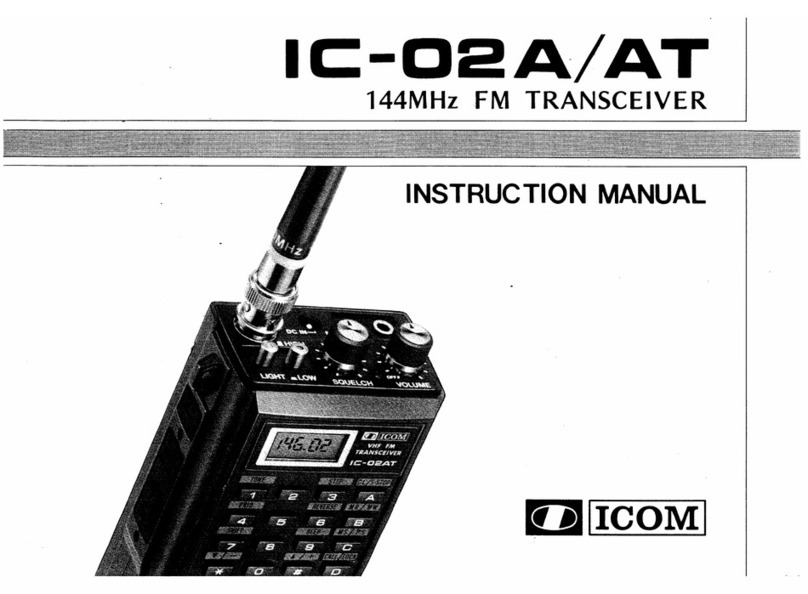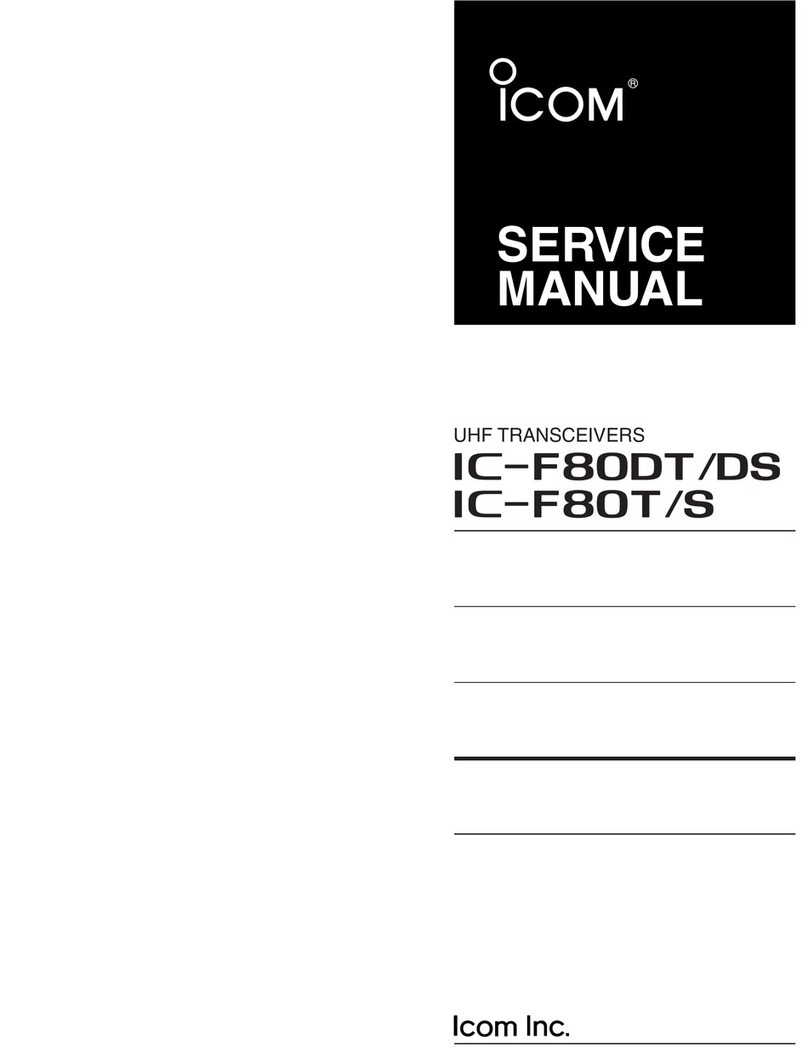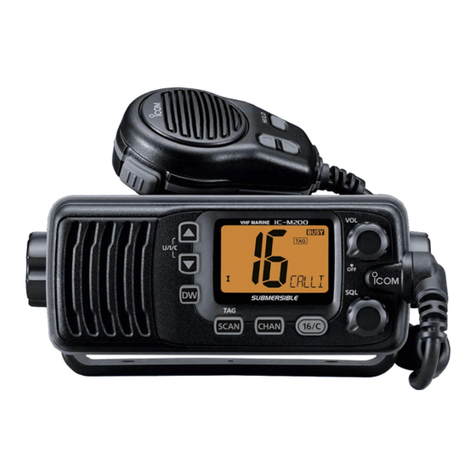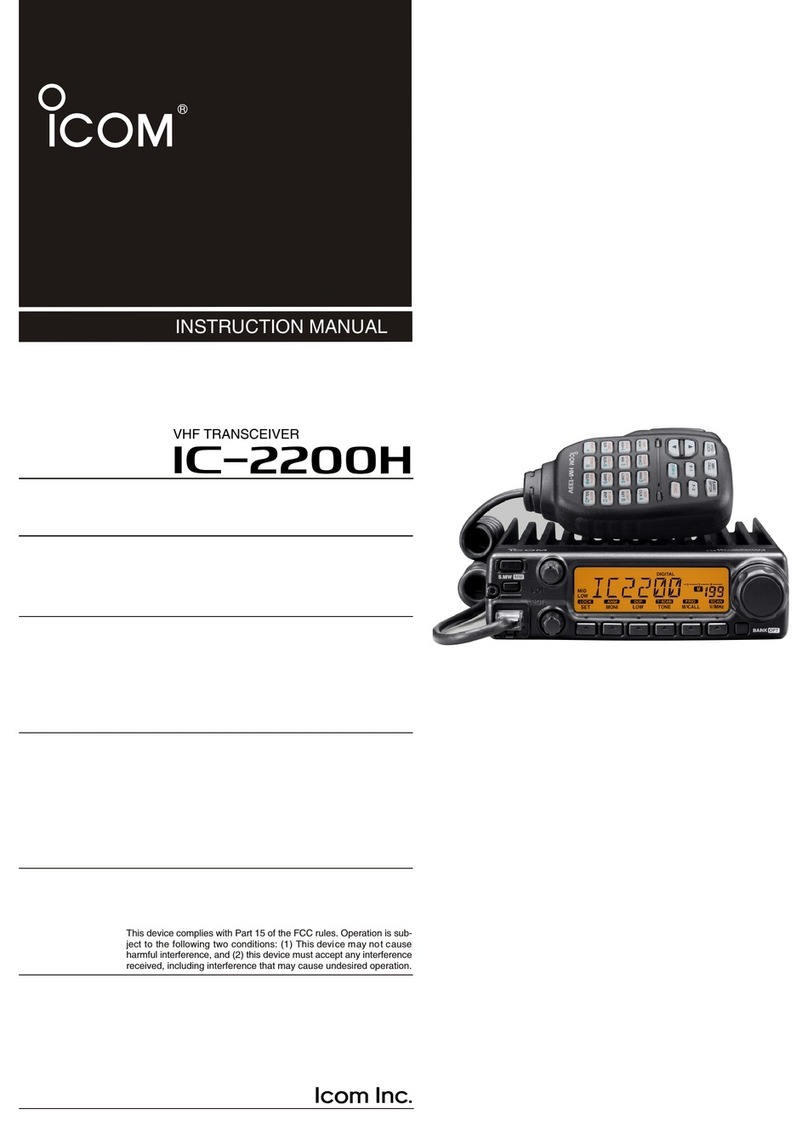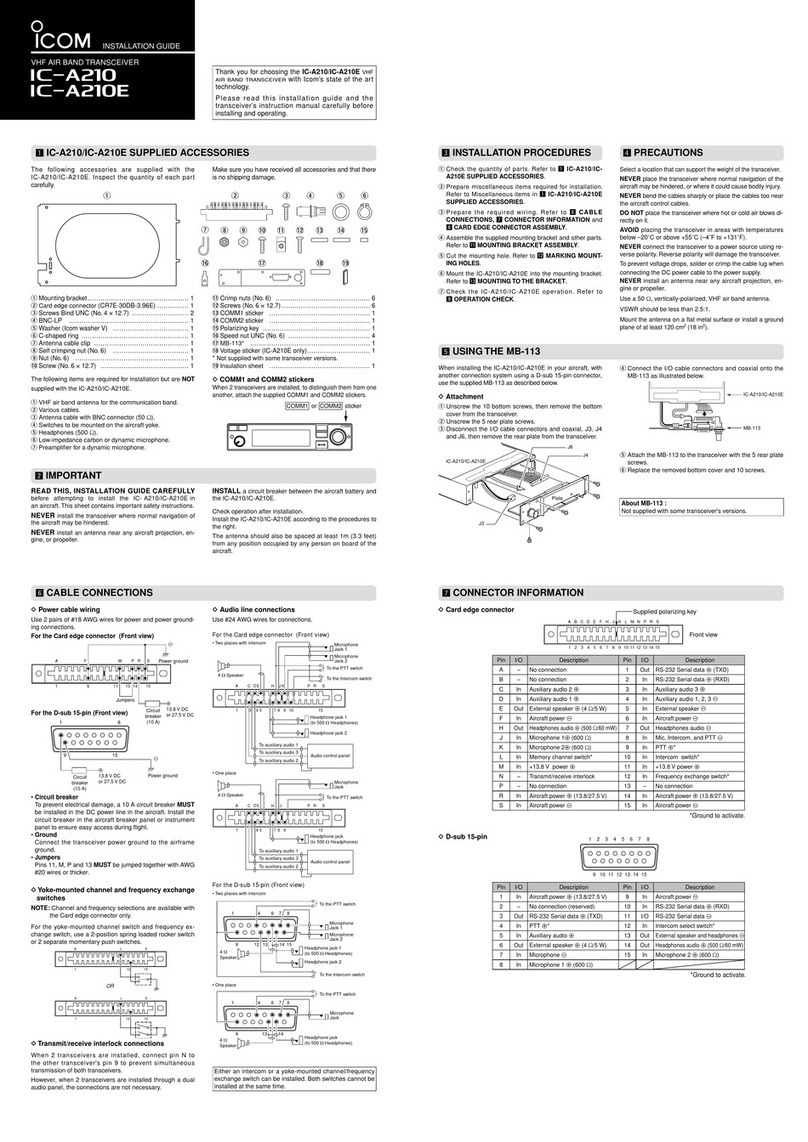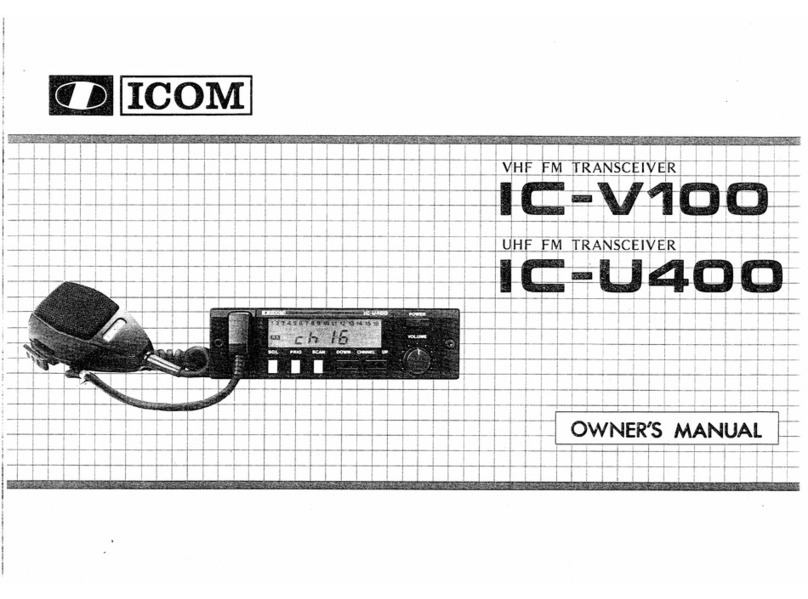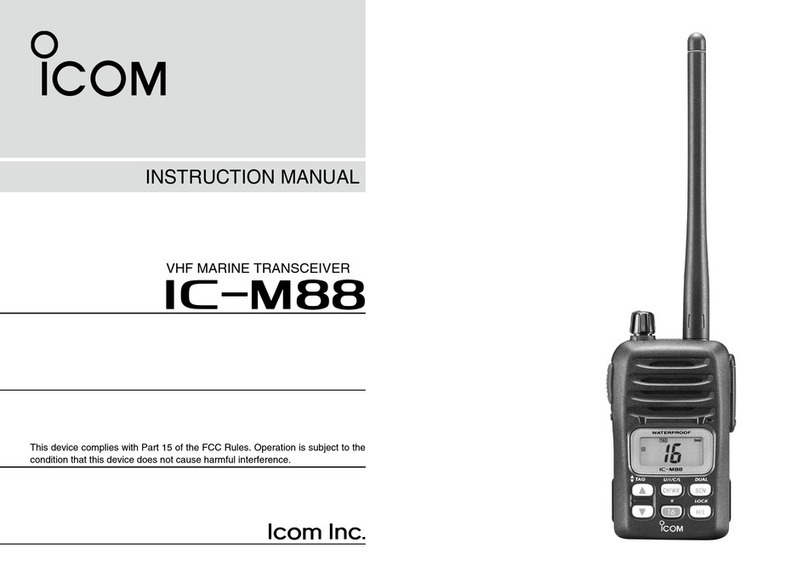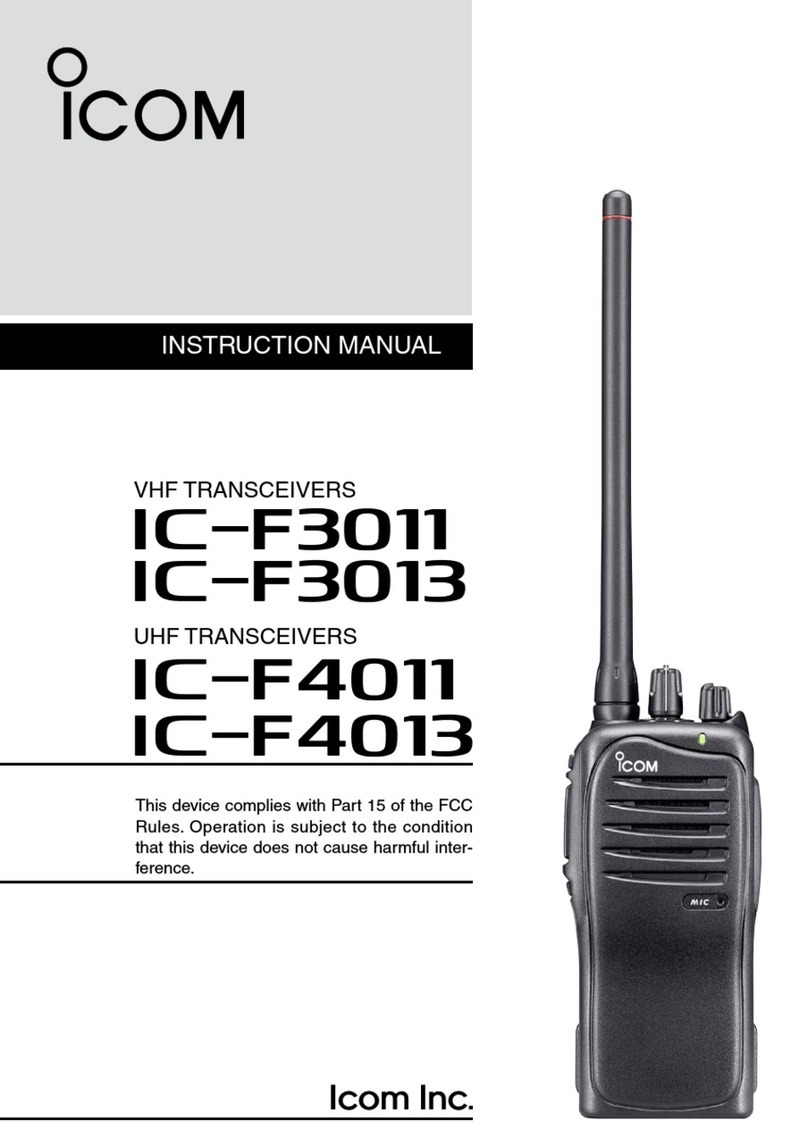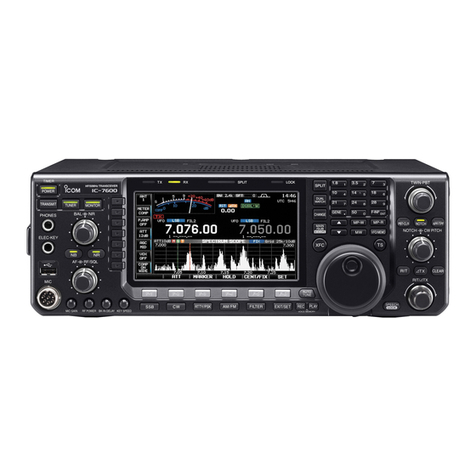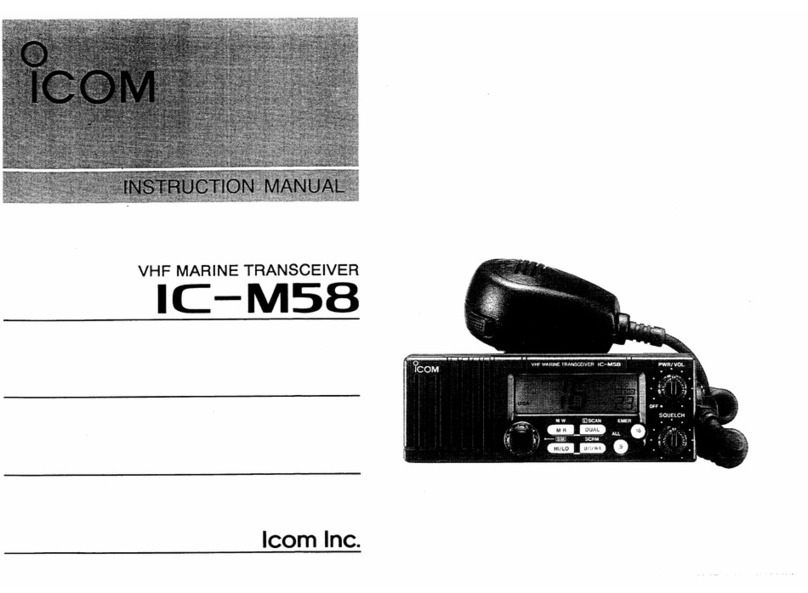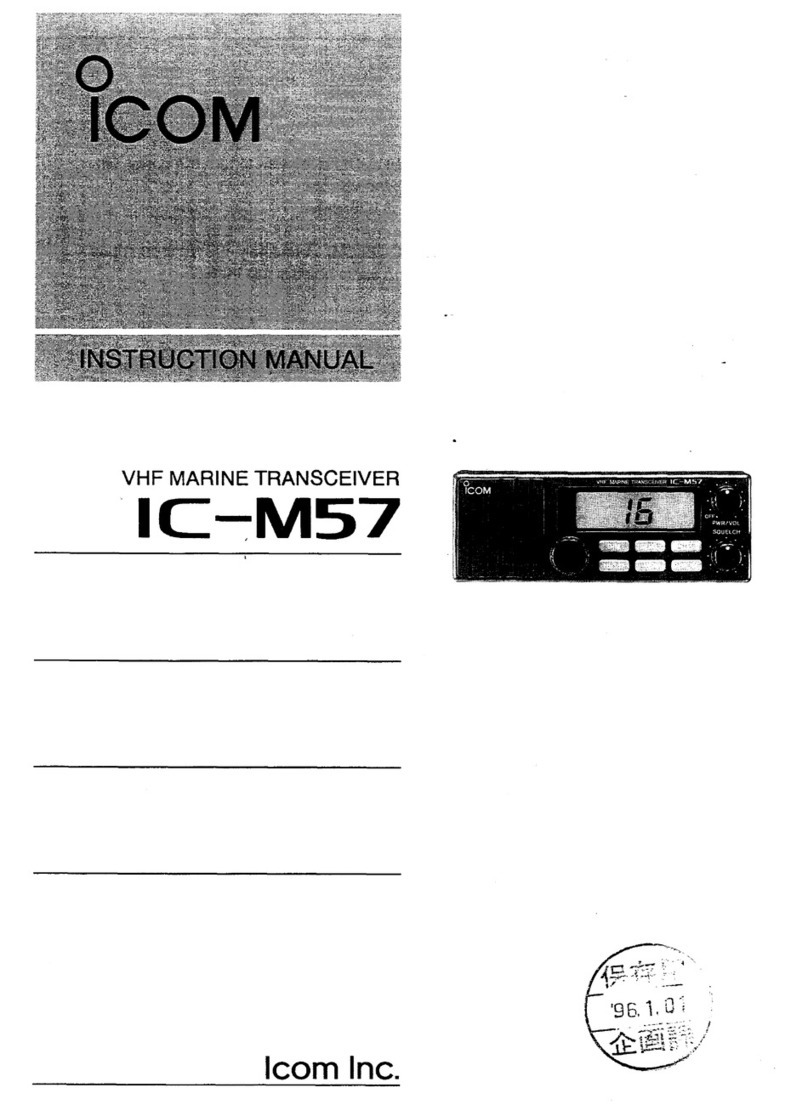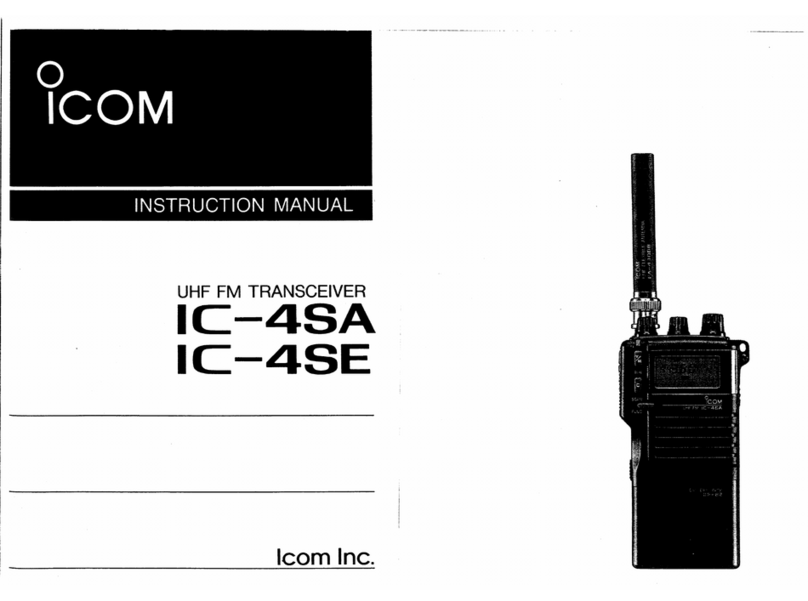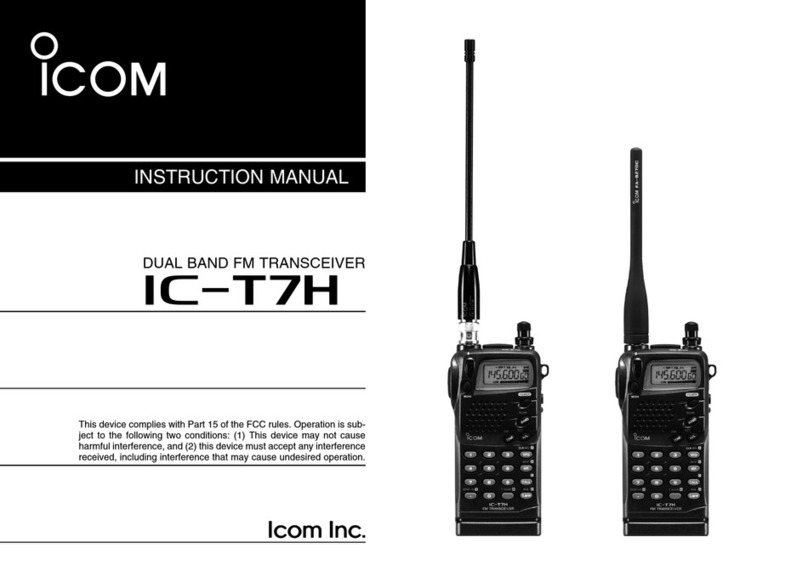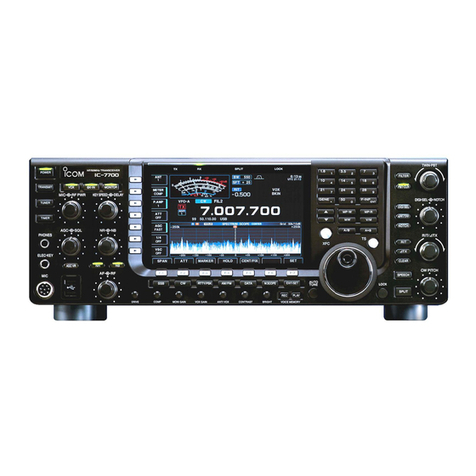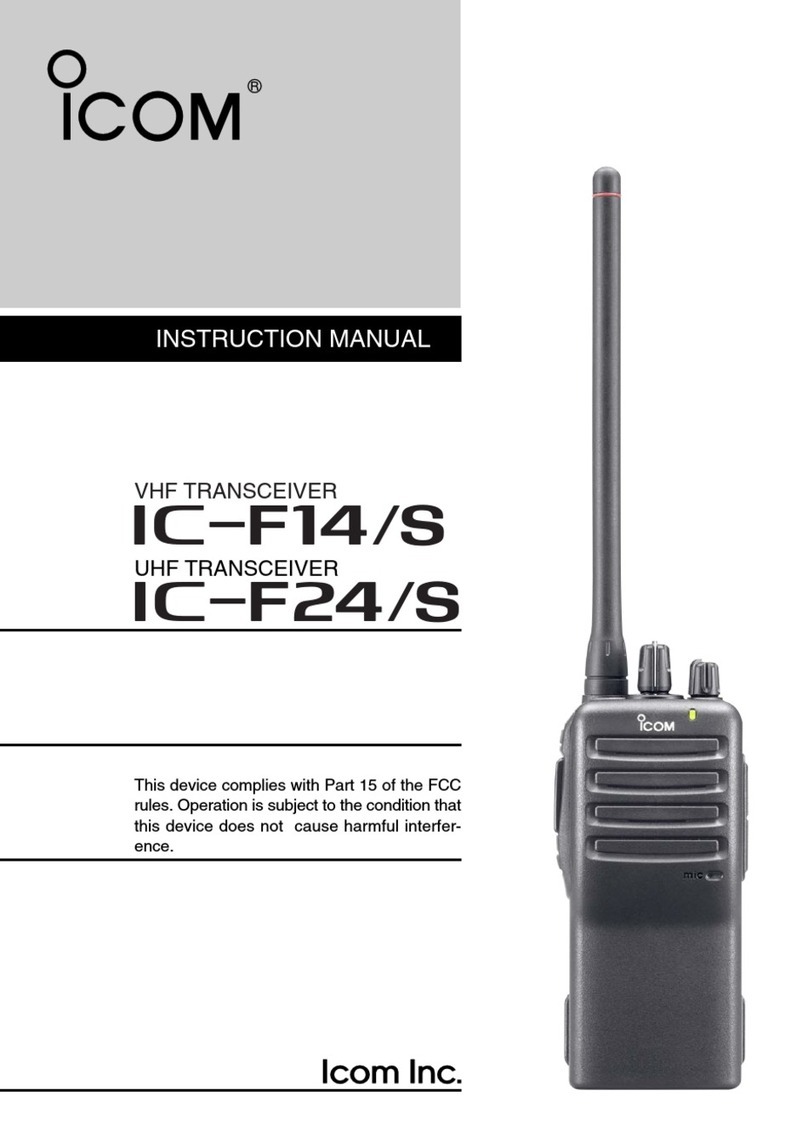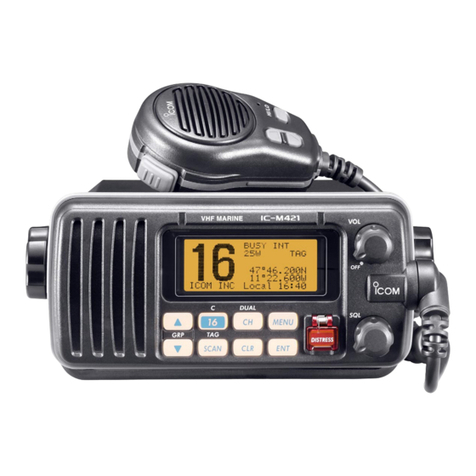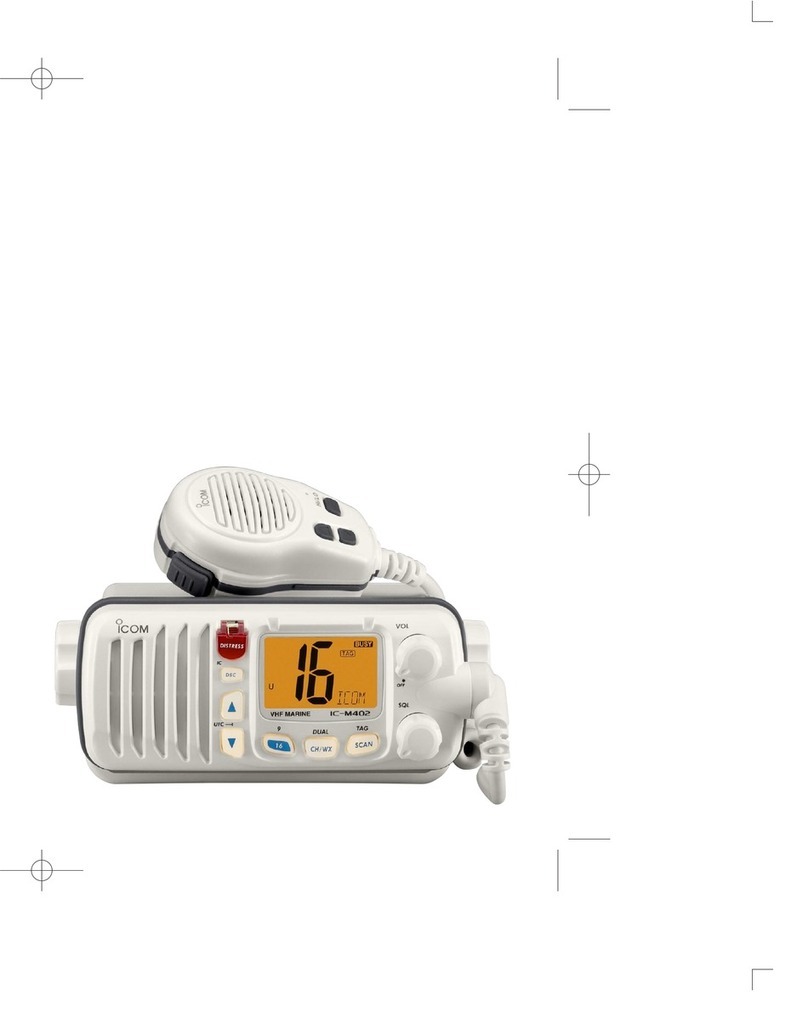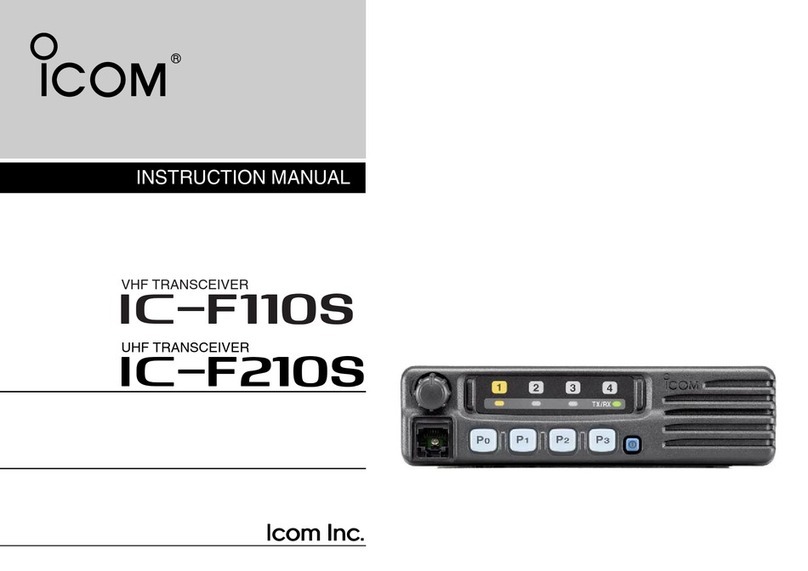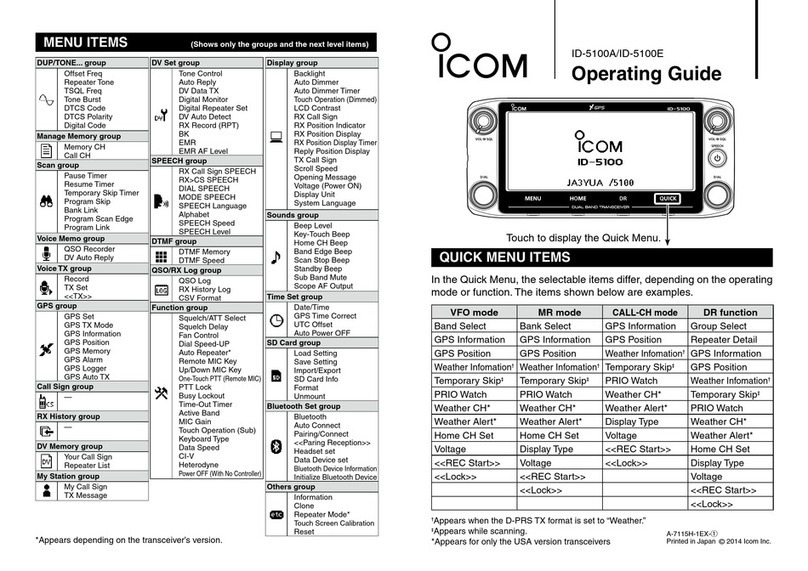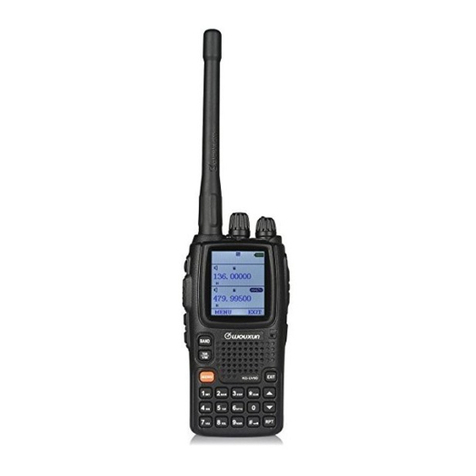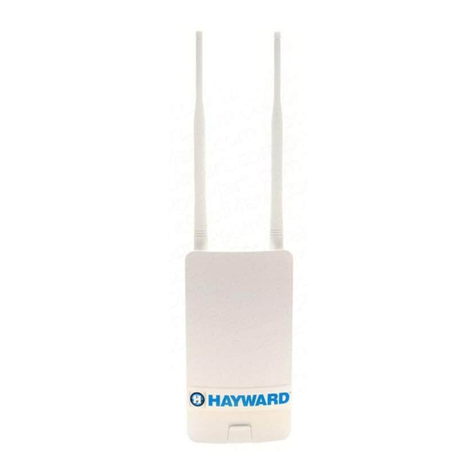Icom ic-2730A User manual

S-15120XZ-C1
March 2015
DUAL BAND TRANSCEIVER

This service manual describes the latest technical informa-
tion for the IC-2730A and IC-2730E DUAL BAND TRANSCEIVER, at
the time of publication.
NEVER connect the transceiver to an AC outlet or to a DC
power supply that uses more than the specified voltage. This
will ruin the transceiver.
DO NOT expose the transceiver to rain, snow or liquids.
DO NOT reverse the polarities of the power supply when con-
necting the transceiver.
DO NOT apply an RF signal of more than 20 dBm (100 mW)
to the antenna connector. This could damage the transceiv-
er’s front-end.
To upgrade quality, any electrical or mechanical parts
and internal circuits are subject to change without notice
or obligation.
MODEL VERSION VERSION
NUMBER TX POWER
IC-2730A
TPE-01 #04 25 W/15 W/5 W
USA-01 #05
50 W/15 W/5 W
KOR-01 #06
EXP-01 #09
IC-2730E
EUR-01 #02
ITR-01 #03
CHN-01 #10
Be sure to include the following four points when ordering
replacement parts:
1. 10-digit Icom part number
2. Component name
3. Equipment model name and unit name
4. Quantity required
<ORDER EXAMPLE>
1110003491 S.IC TA31136FNG IC-2730A MAIN UNIT 5 pieces
8820001210 Screw 2438 screw IC-2730E Top cover 10 pieces
Addresses are provided on the inside back cover for your
convenience.
ORDERING PARTS
1. Make sure that the problem is internal before dis-assem-
bling the transceiver.
2. DO NOT open the transceiver until the transceiver is dis-
connected from its power source.
3. DO NOT force any of the variable components. Turn them
slowly and smoothly.
4. DO NOT short any circuits or electronic parts. An insulated
tuning tool MUST be used for all adjustments.
5. DO NOT keep power ON for a long time when the trans-
ceiver is defective.
6. DO NOT transmit power into a Standard Signal Generator
or a Sweep Generator, otherwise the RF power may dam-
age them.
7. ALWAYS connect a 50 dB to 60 dB attenuator between the
transceiver and a Deviation Meter or Spectrum Analyzer,
when using such test equipment.
8. READ the instructions of the test equipment thoroughly
before connecting it to the transceiver.
REPAIR NOTES
INTRODUCTION CAUTION
(IC-2730A)
Icom, Icom Inc. and the Icom logo are registered trademarks of Icom Incorporated (Japan) in Japan, the United States, the
United Kingdom, Germany, France, Spain, Russia, Australia, New Zealand, and/or other countries.

TABLE OF CONTENTS
SECTION 1 SPECIFICATIONS
SECTION 2 INSIDE VIEWS
SECTION 3 DISASSEMBLY INSTRUCTION
SECTION 4 CIRCUIT DESCRIPITON
4-1 RECEIVER CIRCUITS...................................................................................... 4-1
4-2 TRANSMIT CIRCUITS...................................................................................... 4-5
4-3 FREQUENCY SYNTHESIZER CIRCUITS ....................................................... 4-7
4-4 VOLTAGE BLOCK DIAGRAM ........................................................................... 4-8
SECTION 5 ADJUSTMENT PROCEDURES
5-1 PREPARATION ................................................................................................. 5-1
5-2 FREQUENCY ADJUSTMENT .......................................................................... 5-3
5-3 TRANSMIT ADJUSTMENT............................................................................... 5-3
5-4 RECEIVE ADJUSTMENT ................................................................................. 5-5
SECTION 6 PARTS LIST
SECTION 7 MECHANICAL PARTS
SECTION 8 BOARD LAYOUTS
SECTION 9 BLOCK DIAGRAM
SECTION 10 VOLTAGE DIAGRAM

1-1
SECTION 1.SPECIFICATIONS
DGeneral
• Frequency coverage:
EUR RX 118–174 MHz*1, 375–550 MHz*2
TX 144–146 MHz, 430–440 MHz
ITR RX 118–136.99166 MHz*3, 144–146 MHz, 430–434 MHz, 435–438 MHz
TX 144–146 MHz, 430–434 MHz, 435–438 MHz
TPE RX, TX 144–146 MHz, 430–432 MHz
USA RX 118–174 MHz*4, 375–550 MHz*5
TX 144–148 MHz, 430–450 MHz*5
KOR RX, TX 144–146 MHz, 430–440 MHz
EXP,
CHN
RX 118–174 MHz*4, 375–550 MHz*2
TX 137–174 MHz*4, 400–470 MHz*2
*
1
Guaranteed only 144–146 MHz *
2
Guaranteed only 430–440 MHz *
3
Not guaranteed *
4
Guaranteed only 144–148 MHz *
5
Guaranteed only 430–450 MHz
• Mode: F2D/F3E (FM/FM-N),
A3E (AM/AM-N) RX only
• Number of memory channels: 1000 channels
• Number of program scan channels: 25 channels
(2 edge frequencies in each channel)
• Number of call channels: 2 channels
• Scan types: Full, Band, Program, Priority, Memory channel, Bank, Skip and Tone scans
• Antenna connector: SO-239
• Antenna impedance: 50 ø
• Usable temperature range: –10˚C to +60˚C, +14˚F to +140˚F
• Frequency stability: ±2.5 ppm (−10˚C to +60˚C, +14˚F to +140˚F)
• Frequency resolution: 5 kHz, 6.25 kHz, 8.33 kHz, 10 kHz, 12.5 kHz, 15 kHz, 20 kHz, 25 kHz, 30 kHz, 50 kHz
The 8.33 kHz step is not selectable, depending on the operating band or mode.
• Power supply: 13.8 V DC ±15% (negative ground)
• Current drain:
Transmit
Maximum current drain: 10.5 A at 25 W (TPE version)
13.0 A at 50 W (Other versions)
Receive
Standby: 1.2 A
Maximum audio: 1.8 A
• Dimensions (projections not included):
Main unit: 150(W) 40(H) 151(D) mm, 5.9(W) 1.6(H) 5.9(D) inches
Controller:
150(W) 50(H) 27.2(D) mm,
5.9(W) 2(H) 1.1(D) inches
• Weight (approximately):
Main unit: 1.2 kg, 2.6 lb
Controller: 140 g, 4.9 oz
DTransmitter
• Modulation system: Variable reactance frequency modulation
• Type of emission: F2D, F3E
• Maximum deviation:
FM: ±5.0 kHz
FM-N: ±2.5 kHz
• Input impedance (Mic): 600 ø
• Spurious emission: –60 dBc
• Output power: High 25 W, Mid 15 W, Low 5 W (TPE version)
High 50 W, Mid 15 W, Low 5 W (Other versions)

1-2
DReceiver
• Receive system: Double superheterodyne system
• IF frequencies:
Left band 1st IF 38.85 MHz
2nd IF 450 kHz
Right band 1st IF 46.35 MHz
2nd IF 450 kHz
• Sensitivity (except spurious points):
Amateur bands
FM/FM-N (12 dB SINAD)
0.18 µV
Except Amateur bands
FM/FM-N (12 dB SINAD)
0.32 µV (137.000–159.995 MHz)
0.56 µV (160.000–174.000 MHz)
0.56 µV (375.000–399.995 MHz)
0.32 µV (400.000–499.995 MHz)
0.56 µV (500.000–550.000 MHz)
AM (10 dB S/N)
1 µV (118.000–136.99166 MHz)
• Squelch sensitivity: 0.13 µV (Threshold)
• Selectivity:
FM 60 dB
FM-N 55 dB
• Spurious and image rejection ratio:
60 dB
55 dB (Left band UHF)
• AF output power: 2.0 W (at 10% distortion into an 8 øload)
• Output impedance (Speaker): 8 ø

2-1
SECTION 2.INSIDE VIEWS
• CONTROL UNIT
RESET IC
(IC5)
+3.3 V REGULATOR
(IC7)
CLONING DATA LINE BUFFER
(IC102)
LCD DRIVER
(IC2)
CPU
(IC1)
+3.3 V REGULATOR
(IC6)

2-2
• MAIN UNIT
(TOP VIEW)
EXPANDER
(IC315)
MIC MUTE SW/MIC GAIN SW
(IC100)
VOX AMP/IDC AMP/AF LPF
(IC112)
AF LPF/AF BUFFER
(IC103)
D/A CONVERTER
(IC102)
MODULATION MUTE SW
(IC205)
IF IC (Right band)
(IC120)
1ST IF FILTER (Right band)
(FI104)
AF SW
(IC109)
ELECTRONIC VOLUME IC
(IC110)
+3.3 V REGULATOR
(IC314)
D/A CONVERTER
(IC1)
1ST IF FILTER (Right band)
(FI105)
EXPANDER
(IC316)
IF IC (Left band)
(IC121)
NOISE AMP (Right band)
(IC122)
NOISE AMP (Left band)
(IC123)
EXPANDER
(IC317)
MIC AMP
(IC101)
AND LOGIC GATE IC
(IC108)
CLONING DATA LINE BUFFER
(IC312)
AF LINE MUTE SW
(IC111)
+5 V REGULATOR
(IC319)
EEPROM
(IC301)
RESET IC
(IC308)

2-3
TX POWER AMP (UHF band)
(IC4)
TX POWER AMP
(VHF band)
(IC3)
• MAIN UNIT
(BOTTOM VIEW)
AF MUTE SW
(IC104)
CPU
(IC300)
+3.3 V REGULATOR
(IC306)
PLL IC (Left band)
(IC201)
AF POWER AMP
(IC106)
AF POWER AMP
(IC105)
+8 V REGULATOR
(IC325)
+8 V REGULATOR
(IC313)
+8 V REGULATOR
(IC321)
REFERENCE FREQUENCY
OSCILLATOR (Right band)
(X201)
PLL IC (Right band)
(IC206)
2ND IF FILTER (Right band)
(FI100)
2ND IF FILTER (Right band)
(FI101)
DISCRIMINATOR (Right band)
(X101)
2ND IF FILTER (Left band)
(FI102)
2ND IF FILTER (Left band)
(FI103)
AF LINE SW
(IC119)
DISCRIMINATOR (Left band)
(X102)
REFERENCE FREQUENCY
OSCILLATOR (Left band)
(X200)
CLOCK OSCILLATOR
(X300)
VOLTAGE DETECTOR IC
(IC320)
VOLTAGE DETECTOR IC
(IC324)
+3.3 V REGULATOR
(IC311)
CURRENT DETECTOR IC
(IC310)

3-1
SECTION 3.DISASSEMBLY INSTRUCTION
1. Removing the CONTROL UNIT
1) Remove all knobs from the controller.
Controller
2) Remove four screws from the rear panel.
3) Separate the rear panel from the front panel as-
sembly.
Front panel assembly
Rear panel
4) Remove the CONTROL UNIT from the front panel.
Front panel
CONTROL UNIT
2. Removing the MAIN UNIT
1) Remove eight screws from the top cover.
2) Remove the top cover from the chassis.
Top cover
CHASSIS
Screws ×8
3) Disconnect the speaker cable from the MAIN UNIT.
4) Remove the clip from the chassis.
SPEAKER
CABLE
Speaker
CHASSIS
Clip
5) Remove seven screws from the bottom cover.
CHASSIS
Bottom cover
Screws×7
(Continued on the next page.)

3-2
6) Unsolder three points at the antenna connector.
7) Disconnect the cooling fan cable.
Solder
remover
COOLING FAN
CABLE
UNSOLDER
8) Remove total of 17 screws from the MAIN UNIT.
Screws ×17
9) Remove the MAIN UNIT from the chassis.
MAIN UNIT
CHASSIS

4-1
SECTION 4.CIRCUIT DESCRIPTION
4-1 RECEIVE CIRCUITS
RF CIRCUITS
The received signal from the antenna connector passed
through the LPF (L90, L94, L96, C409, C418 and C428). The
filtered signal is applied to either the VHF or UHF band’s RF
circuit.
VHF BAND (118–174 MHz)
The received VHF band signal from the LPF (L90, L94, L96,
C409, C418 and C428) is passed through the LPF (L79, L83,
L87, C378, C386 and C394) and TX/RX SW (D66, D69 to
D71 and D77), and applied to the PRE-AMP (Q24).
• Left band
The amplified signal is passed through the attenuator (D34)
and tuned BPF (D28, D88, L31, L34, C119, C127, C128 and
C135), and applied to the RF AMP (Q20). The amplified sig-
nal is passed through the tuned BPF (D20, D87, L10, L18,
C60, C71, C74, C79 and C86), and then applied to the 1st
mixer (Q145).
• Right band
The amplified signal is passed through the attenuator (D33)
and tuned BPF (D27, D85, L23, L32, L33, C116, C125, C126
and C132), and applied to RF AMP (Q19). The amplified sig-
nal is passed through the tuned BPF (D19, D86, L9, L17,
C57, C69, C70, C77 and C84), and then applied to the 1st
mixer (Q143).
UHF BAND (375–550 MHz)
The received UHF band signal from the LPF (L90, L94, L96,
C409, C418 and C428) is passed through the HPF (L84, L88,
C392, C395 and C429), TX/RX SW (D68, D73, D75, D84,
L86, L92, C387, C396 and C413), and applied to the PRE-
AMP (Q23).
• Left band
The amplified signal is passed through the attenuator (D32)
and tuned BPF (D22, D24, D26, D30, L21, L28 and L101),
and applied to the RF AMP (Q18). The amplified signal is
passed through the tuned BPF (D12, D16, D91, D92, L4,
L12, L16, L102, C33, C65 and C67), and then applied to the
1st mixer (Q146).
• Right band
The amplified signal is passed through the attenuator (D31)
and tuned BPF (D21, D23, D25, D29, L22, L27 and L99), and
applied to the RF AMP (Q17). The amplified signal is passed
through the tuned BPF (D11, D15, D89, D90, L3, L11, L15,
L100, C32, C63 and C66), and then applied to the 1st mixer
(Q144).
RF CIRCUITS
BPF
HPF
RF
AMP
RF
AMP
ATT
TX/RX
SW
BPF
BPF
BPF
ATT
RF
AMP
LPF
BPF
ANTENNA
BPF
RF
AMP BPF
LPF
RF
AMP
RF
AMP
ATT
TX/RX
SW
BPF
ATT
LIMITER LIMITER
118-550MHz
118-174MHz
375-550MHz
118-174MHz
Left band
(VHF)
Right band
(VHF)
Left band
(UHF)
Right band
(UHF)
375-550MHz
400-470MHz
137-174MHz
VHF TX circuit
UHF TX circuit
D68,D73,
D84,D75
D66,D69
D79D81
Q24
D34D28,D88Q20D20,D87
D33D27,D85Q19D19,D86
Q23
D32D22,D24,D26,D30Q18D12,D16,D91,D92
D31D21,D23,D25,D29Q17D11,D15,D89,D90
D70,D71,D77

4-2
1ST IF CIRCUITS
VHF BAND
• Left band
The received signal from the RF circuit and 1st LO signal are
applied to the 1st IF mixer (Q145) and mixed, resulting in the
38.85 MHz 1st IF signal.
The 1st IF signal is applied to the 1st IF filter (FI105), through
the band SW (D121).
• Right band
The received signal from the RF circuit and 1st LO signal are
applied to the 1st IF mixer (Q143) and mixed, resulting in the
46.35 MHz 1st IF signal.
The 1st IF signal is applied to the 1st IF filter (FI104), through
the band SW (D119).
UHF BAND
• Left band
The received signal from the RF circuit and 1st LO signal are
applied to the 1st IF mixer (Q146) and mixed, resulting in the
38.85 MHz 1st IF signal.
The 1st IF filter is applied to the 1st IF filter (FI105), through
the band SW (D122).
• Right band
The received signal from the RF circuit and 1st LO signal are
applied to the 1st IF mixer (Q144) and mixed, resulting in the
46.35 MHz 1st IF signal.
The 1st IF signal is applied to the 1st IF filter (FI104), through
the band SW (D120).
The filtered signal is amplified by the IF AMP (Q137), and ap-
plied to the IF IC (IC120, pin 20).
1ST IF CIRCUITS
IF
AMP BPF
XTAL
IF
AMP BPF
XTAL
RX
SW
RX
SW
Left band VHF RF circuit
Right band VHF RF circuit
Left band UHF RF circuit
Left band 1st LO (UHF)
Right band 1st LO (UHF)
Right band 1st LO (UHF)
Left band 1st LO (VHF)
Right band UHF RF circuit
Left band 1st IF circuit
Right band 1st IF circuit
Left band
2nd IF circuit
Right band
2nd IF circuit
46.35MHz
38.85MHz
Q137 FI104
Q138 FI105
Q144
Q146
Q143
Q145
D119,D120
D121,D122
2ND IF CIRCUITS
• Left band
IC121 is an IF IC, which contains the 2nd mixer, limiter AMP,
noise AMP, quadrature detector, AM detector, AGC controller,
signal strength detector, and so on.
The 1st IF signal from the 1st IF AMP (Q138) and 38.4 MHz
2nd LO signal are mixed, resulting in the 450 kHz 2nd IF sig-
nal.
The 2nd IF signal is output from pin 3, and passed through
the ceramic filter (FI102: For FM-N or FI103: For FM), and
then applied to IC121 from pins 5 and 7.
• Right band
IC120 is an IF IC, which contains the 2nd mixer, limiter AMP,
noise AMP, quadrature detector, AM detector, AGC controller,
signal strength detector, and so on.
The 1st IF signal from the 1st IF AMP (Q137) and 45.9 MHz
2nd LO signal are mixed, resulting in the 450 kHz 2nd IF sig-
nal.
The 2nd IF signal is output from pin 3, and passed through
the ceramic filter (FI100: For FM-N or FI101: For FM), and
then applied to IC120 from pins 5 and 7.
FM DEMODULATION CIRCUITS
• Left band
The 2nd IF signal applied pin 7 is amplified by the limiter AMP,
and then demodulated by the quadrature detector with the
ceramic resonator (X102).
The demodulated AF signal is output from pin 11, and then ap-
plied to the AF circuit, through the AF SW (IC119, pins 8, 9).
• Right band
The 2nd IF signal applied pin 7 is amplified by the limiter AMP,
and then demodulated by the quadrature detector with the
ceramic resonator (X101).
The demodulated AF signal is output from pin 11, and then ap-
plied to the AF circuit, through the AF SW (IC119, pins 1, 2).

4-3
AM DETECTOR CIRCUITS
• Left band
The 2nd IF signal applied from pin 5 is amplified by the IF
AMP, and then demodulated by the amplitude detector in the
IF IC (IC121).
The demodulated AF signal is output from pin 14, and
then applied to the AF circuits, through the AF SW (IC119,
pins 11, 10).
In the AM mode, the AGC circuit in the IF IC automatically
adjusts the gain of RF AMPs (Q18 and Q20) and 1st IF AMP
(Q138), to keep the signal level constant.
The demodulated AF signal is applied to the RX AF circuit.
• Right band
The 2nd IF signal applied from pin 5 is amplified by the IF
AMP, and then demodulated by the amplitude detector in the
IF IC (IC120).
The demodulated AF signal is output from pin 14, and then
applied to the AF circuits, through the AF SW (IC119, pins
4, 3).
In the AM mode, the AGC circuit in the IF IC automatically
adjusts the gain of RF AMPs (Q17 and Q19) and 1st IF AMP
(Q137), to keep the signal level constant.
The demodulated AF signal is applied to the RX AF circuit.
2ND IF AND DEMODULATOR CIRCUITS (Left band)
BPF
CERAMIC
BPF
CERAMIC
X3
DET OUT
SELECT IF IC
FM
AM
Left band
1st IF circuit
Left band
AF circuit
LIF
WIDE/NARROW
12.8MHz
38.4MHz
X200
Q200
IC119 IC121
D107,D108,D111,D112
FI102 FI103
X102
2ND IF AND DEMODULATOR CIRCUITS (Right band)
BPF
CERAMIC
BPF
CERAMIC
X3
DET OUT IF IC
WIDE/NARROW
SELECT
15.3MHz
AM
FM
Right band
AF circuit Right band
1st IF circuit
RIF
45.9MHz
X201
Q220
IC120IC119
D105,D106,D109,D110
FI100 FI101
X101

4-4
RX AF CIRCUITS
• Left band
The demodulated AF signal from the AF SW (IC119) is
passed through the AF mute SW (IC111, pins 4, 3) and AF fil-
ter (Q113), and then applied to the volume IC (IC110, pin 4),
which adjusts the AF signal in level.
The level-adjusted AF signal from the volume IC (IC110,
pin 11) is passed through the AF SW (IC109, pins 2, 1), which
selects the AF signal from Left and Right bands.
• Right band
The demodulated AF signal from the AF SW (IC119) is
passed through the AF mute SW (IC111, pins 8, 9) and AF
filter (Q112), and then applied to the volume IC (IC110, pin 3),
which adjusts the AF signal in level.
The level-adjusted AF signal from the volume IC (IC110,
pin 12) is passed through the AF SW (IC109, pins 3, 4), which
selects the AF signal from Left and Right bands.
When output from [EXTERNAL SPEAKER JACK1]
The output signal from the AF SW (IC109) is passed through
the AF MUTE SW (Q104 and Q105), and applied to the AF
AMP (IC105, pin 1).
The amplified AF signal is applied to the internal speaker
(CHASSIS: SP1) or an external speaker, through [EXTER-
NAL SPEAKER JACK1] (J101).
When output from [EXTERNAL SPEAKER JACK2]
The output signal from the AF SW (IC109) is passed through
the AF MUTE SW (Q106), and applied to the AF AMP (IC106,
pin 1).
The amplified AF signal is applied to [EXTERNAL SPEAKER
JACK2] (J102).
AF
AMP
SP1
AF
AMP
LPF
BUFF
J102
J101
BUFF
BUFF
AFSW
FIL
SP
MUTE
VR
ELEC.
MUTE
SP
AF
DETMUTE
AF
FIL
SP
MUTE
BTAF
Optional module
RPT
RPT
SW
IC106 Q106
IC105 Q104 Q105
IC109
IC107
IC104
IC103
Modulation circuit
TX AF circuit
2nd IF circuit (Left band )
2nd IF circuit (Right band )
IC110 IC111
Q112,Q139
Q113,Q140
IC103
IC103
L_RMUTE R_RMUTE
• RX AF CIRCUITS

4-5
4-2 TRANSMIT CIRCUITS
TX AF CIRCUIT (CONTROL AND MAIN UNITS)
When the microphone is connected to the controller:
The AF signal from the microphone is applied to the MIC
AMP (CONTROL UNIT: IC102, pin 2), through [MIC] (CON-
TROL UNIT: J101).The amplified MIC signal is applied to the
MIC line SW (MAIN UNIT: IC100, pin 1) on the MAIN UNIT,
through the control cable.
When the microphone is directly connected to the MAIN UNIT:
The AF signal from the microphone is applied to the MIC
AMP (MAIN UNIT: IC101, pin 5), through [MIC] (MAIN UNIT:
J100).
The amplified MIC signal is passed through the MIC line
SW (MAIN UNIT: IC100, pins 11, 10), MIC gain SW (MAIN
UNIT: Q151 and Q152), MIC mute SW (MAIN UNIT: IC100,
pins 9, 8) and the HPF (MAIN UNIT: R774, C861 and C862),
and then adjusted in amplitude by the IDC AMP (MAIN UNIT:
IC112, pins 3, 1), and passed through the splatter filter (MAIN
UNIT: IC112, pins 13, 14) and LPF (MAIN UNIT: IC103,
pins 6, 7), and then applied to the D/A converter (MAIN UNIT:
IC102, pin 13).
The level-adjusted MIC signal is passed through the modula-
tion mute SW (MAIN UNIT: VHF band IC205, pins 2, 1/UHF
band IC205, pins 3, 4), and then applied to the modulation
circuit as the modulation signal.
TX AF CIRCUIT
D/A
Splatter
LPF
HPF
J100
1
2
3
4
5
6
7
8
LPF
IDC
MIC
AMP
BUFF
MIC
GAIN
SW
J101
1
2
3
4
5
6
7
8
MIC
AMP
MUTE
SW
MIC
RPT
RPT
Left band RX signal
Right band RX signal
SW
BTMIC
From the
optional
unit
5
3
6
1
4
2
CONTROL UNIT
MAIN UNIT
[MIC]
J6
IC307
Q151/Q152
IC101
IC112IC100 IC112
IC104
IC103 IC102
MIC
MIC
8V
MICE
PTT
MICIN
EXTMIC
IC102
GND
MICU/D
MIC
SW
IC100
MODULATION CIRCUITS (MAIN UNIT)
The modulation signal from the TX AF circuit is applied to the
VCO as the frequency modulation signal.
VHF BAND
The modulation signal is applied to the VHF VCO (Q211,
D203, D204, D206, D228 and D342).
The modulated VCO output signal is amplified by the buffer
(Q215), passed through the LO SW (D208), amplified by the
LO AMP (Q240), and then applied to the TX AMP circuit as
the TX signal, through another LO SW (D50).
UHF BAND
The modulation signal is applied to the UHF VCO (Q232,
D223, D224, D227, D229 and D236).
The modulated VCO output signal is amplified by the buffer
(Q235), and then applied to the TX AMP circuit as the TX
signal.
MODULATION CIRCUITS
LO
AMP
BUFF
BUFF TX/RX
SW
VCOMOD MOD
MUTE
R_UHF
L_VHF
LVCO
IC205
Q215
Q211
Q240
Q232
Q235
D50
D223
D224
D203
D204
D206
D227
D229
D342
D228
D236
UHF TX CIRCUIT
VHF TX CIRCUIT

4-6
HPFLPF
PWR
AMP
TX/RX
SW
LPF
DRIVE
AMP
PWR
AMP
LPF
ANTENNA
DRIVE
PRE
ATT
LPF
DRIVE
AMP
HPF
TX/RX
SW
DRIVE
PRE
ATT
APC
CTRL
PWR
DET
PWR
DET
ATT
ATTLPF
LPFHPF
LO
AMP LIMITER
118-550MHz
118-174MHz
375-550MHz
PCON(V/U)
LIMITER
UHF BAND
UHF RX CIRCUIT
VHF RX CIRCUIT
VHF BAND
Q38 D55 Q41 IC4 D62/D67
D68/D73/
D84/D75
Q36 D53 Q40 IC3 D59/D63
D66/D69
IC2
Q37
D70/D71/D77
UHF band
VHF band
TX AMP CIRCUITS (MAIN UNIT)
VHF BAND
The TX signal from the VHF band modulation circuit is passed
through the LPF (L50, L51, C215, C220 and C225) and ATT
(R146, R147 and R151), and then sequentially amplified by
the pre-drive AMP (Q36), drive AMP (Q40) and power AMP
(IC3).
The amplified TX signal is passed through the LPF (L67, L68,
C291, C297, C301, C302, C326, C331 and C332), TX output
power detector (D59 and D63), ANT SW (D66) and two LPFs:
(L79, L83, L87, C378, C386, C394 and L90, L94, L96, C409,
C418, C428), before being applied to the antenna.
UHF BAND
The TX signal from the UHF band modulation circuit is ampli-
fied by the LO AMP (Q37), passed through the HPF (L52 and
C232), ATT (R155, R156 and R162), and then sequentially
amplified by the pre-drive AMP (Q38), drive AMP (Q41) and
power AMP (IC4).
The amplified TX signal is passed through the LPF (L69, L73,
C310, C319, C322, C323, C350, C358 and C359), TX output
power detector (D62 and D67), ANT SW (D68 and D84) and
HPF (L84, L88, C391, C392, C395, C402, C429 and C430)
and LPF (L90, L94, L96, C409, C418 and C428), before be-
ing applied to the antenna.
APC CIRCUITS
VHF BAND
A portion of RF signal is rectified by the power detector di-
odes (D59 and D63) at the LPF (L67, L68, C291, C297,
C301, C302, C326, C331 and C332), and the produced DC
voltage, which represents the TX power level, is used as the
TX power sensing voltage.
The TX power sensing voltage is applied to the APC AMP
(IC2, pin 2), and the power setting voltage from the D/A con-
verter (IC102, pin 8) is also applied to the AMP from pin 3,
resulting in the output voltage which is inversely proportional
to the TX power sensing voltage.
When the TX power sensing voltage increases, the output
voltage, which controls the gain of the power AMP (IC3), de-
creases to control the TX power constant.
UHF BAND
A portion of RF signal is rectified by the power detector di-
odes (D62 and D67) at the LPF (L69, L73, C310, C319,
C322, C323, C350, C358 and C359), and the produced DC
voltage, which represents the TX power level, is used as the
TX power sensing voltage.
The TX power sensing voltage is applied to the APC AMP
(IC2, pin 6), and the power setting voltage from the D/A con-
verter (IC102, pin 7) is also applied to the AMP from pin 5,
resulting in the output voltage which is inversely proportional
to the TX power sensing voltage.
When the TX power sensing voltage increases, the output
voltage, which controls the gain of the power AMP (IC4), de-
creases to control the TX power constant.
TX AMP CIRCUITS

4-7
4-3
FREQUENCY SYNTHESIZER CIRCUITS
(MAIN UNIT)
VCOs
The IC-2730A/E has total of four VCOs: two VCOs for the left
band and another two for the right band.
• Left band
VHF VCO
The VHF VCO (Q211, D203, D204, D206, D228 and D342)
generates the VHF TX signal. The output of buffer (Q215) is
amplified by the LO AMP (Q240), and then applied to the
VHF TX AMP circuit, through the LO SW (D50).
UHF VCO
The UHF VCO (Q210, D201, D202 and D205) generates the
1st LO signal (for receiving a UHF signal on the left band).
The output of buffer (Q214) is amplified by the LO AMP
(Q240), and then applied to the 1st IF mixer (Q146), through
the LO SW (D213) and LPF (L315, C988 and C995).
• Right band
VHF VCO
The VHF VCO (Q233, D225, D226 and D230) generates the
1st LO signal (for receiving a VHF signal on the right band).
The output of buffer (Q236) is amplified by the LO AMP
(Q238), and then applied to the 1st IF mixer (Q143), through
the LO SW (D235) and LPF (L338, L339, C1105 and
C1106).
UHF VCO
The UHF VCO (Q232, D223, D224, D227, D229 and D236)
generates the UHF TX signal. The output of buffer (Q235) is
applied to the UHF TX AMP circuit.
• Left band frequency synthesizer circuit
AMP
BUFF
BUFF
BUFF
LPF
LPF
TX/RX
SW
X3
FIL
LOOP
PLL
IC
IF IC
Left band VCOs
38.4MHz
12.8MHz
X200
IC201
Q200
Q213
Q215
Q211
Q210
Q214 Q240
TX VCO (VHF)
RX VCO (UHF)
D50/D212/D213
IC121
Q146
Q145
D201
D202
D203
D204
D206
D342
D228
D205
137-174MHz
156.85-212.85MHz
336.15-511.15MHz
PLL
The PLL circuit controls the VCO oscillating frequency by
comparing the reference signal and the fed back VCO sig-
nal. When the oscillation frequency drifts, its phase changes
from that of the reference frequency, causing a lock voltage
change to compensate for the drift in the VCO oscillating fre-
quency.
• Left band
A portion of VHF and UHF VCOs output signal is ampli-
fied by the buffer (Q213), and then fed back to the PLL IC
(IC201, pin 17).
The PLL IC (IC201) phase-compares the output of reference
frequency oscillator (TCXO: X200) and VCO, and the phase
difference is output as the charge pump current. The current
is passed though the loop filter (R715, R717, R719, R722,
C924, C926 to C928 and C930) to be converted into the lock
voltage, which controls the oscillating frequency of VCO.
• Right band
A portion of VHF and UHF VCOs output signal is ampli-
fied by the buffer (Q234), and then fed back to the PLL IC
(IC206, pin 17).
The PLL IC (IC206) phase-compares the output of reference
frequency oscillator (TCXO: X201) and VCO, and the phase
difference is output as the charge pump current. The current
is passed though the loop filter (R797, R799, R802, R805,
C1041, C1043 to C1045 and C1048) to be converted into the
lock voltage, which controls the oscillating frequency of VCO.
• Right band frequency synthesizer circuit
AMP
FIL
LOOP BUFF
BUFF
BUFF
PLL
IC
LPFLPF
X3
IF IC
15.3MHz
Right band VCOs
45.9MHz
X201
IC206
Q220
Q234
Q236
Q233
TX VCO (UHF)
RX VCO (VHF)
Q232
Q235
Q238 D234/D235
IC120
Q144
Q143
SW
D223
D224
D225
D226
D227
D229
D230
D236
400-470MHz
164.35-
220.35 MHz
328.65-
503.65 MHz

4-8
4-4 VOLTAGE BLOCK DIAGRAM
Voltage from the power supply is routed throughout the transceiver, through regulators and switches.
W300
+8
REG
PWR
CTRL
+8
REG
+8
REG
UT8
VCC
SW
CPU3.3V
5V
PCON
REG
REG
3VS
5VS
FANHV
REG
IDET
DETECT
CURRENT
NOISE
FILTER
REG
VT8
REG
3.3V
UTX_C
VTX_C
I SENS
3.3V
8V
BT3.3V
BT3V
REG
UT8
VT8
1
3
5
4
6
2
HV
LOW VOLTAGE
DETECTOR
PDV ALARM
To the optional unit
To CPU
5
3
6
1
4
2
8V
8V
CONTROL UNIT
MAIN UNIT
IC310
Q306 IC313
Q301/Q308
IC320,
IC324
IC306/D333
IC311/D325/D332
IC314
IC319
Q32/Q34
Q27/Q28
J300
IC6
8V
VCC
Q302
SW
IC325
VCC
VCC2
8VS
IC321
CONT8V
IC7
REG
3.3V
CTRL3V
SW3C
REG
3.3V

5-1
SECTION 5.ADJUSTMENT PROCEDURE
MCONNECTION
MJIG CABLE
MREQUIRED EQUIPMENTS
EQUIPMENT GRADE AND RANGE EQUIPMENT GRADE AND RANGE
JIG cable Modified modular cable.
(See the illustration shown below.)
Frequency counter
Range: 0.1–600 MHz
Accuracy: ±1 ppm or better
Input level: Less than 1 mW
RF power meter
(50 terminated)
Measuring range: 0.1–60 W
Frequency range: 100–600 MHz
SWR: Less than 1.2 : 1
Modulation
Analyzer
Frequency range: 30–600 MHz
Measuring range: 0 to ±10 kHz Standard signal
generator (SSG)
Frequency range: 0.1–600 MHz
Output level: –20 dBµ to 90 dBµ
(–127 to –17 dBm)
AC millivoltmeter Measuring range: 10 mV to 10 V
Audio generator
(AG)
Frequency range: 300–3000 Hz
Output level: 1–500 mV Attenuator Attenuation: 40 dB
Capacity: More than 60 W
5-1 PREPARATION
8-pin modular jack
q
iuytrew
q
w
e
r
t
y
u
i
8V
MICU/D
EXTMIC
PTT
MICE
MIC
GND
MICIN
y(MIC)
w(MICU/D)
u(GND)
r(PTT)
u(GND)
t(MICE)
AUDIO GENERATOR
(300–3000 Hz/1–500 mV)
+−
22 kΩ
+−
AC MILLIVOLTMETER
(10 mV to 10 V)
PTT
JIG cable
To [MIC]
SETTING;
Frequency : 1 kHz
Level : 20 mVrms (Except [USA] version)
80 mVrms ([USA] version)
Waveform : Sine wave
IC-2730A/E (Rear view)
FM
deviation meter
to the antenna connector
Attenuator
40 dB
RF power meter
0.1–60 W/50 Ω
Frequency
counter
Standard signal generator
–20 dBµ to 90 dBµ
(–127 dBm to –17 dBm)
DO NOT transmit while
an SSG is connected to
the antenna connector.

5-2
• ENTERING THE ADJUSTMENT MODE
1) Connect the JIG cable to [MIC] on the main unit. (See page 5-1.)
2) While holding down both [MAIN BAND], turn ON the power.
• KEY ASSIGNMENTS FOR THE ADJUSTMENT MODE
• QUITTING THE ADJUSTMENT MODE
1) Remove the JIG cable from [MIC].
2) Turn OFF the power, and then turn ON again.
2) Hold down both [MAIN BAND].
1) Connect the JIG cable to [MIC].
3) Push [ ] to turn ON the power.
JIG cable
Main unit (front view)
[DUP MONI]
Selects the next adjustment item.
Adjustment item name.
Indicates that the item is currently adjusted on this side of frequency.
Adjustment value.
[LOW DTMF]
Selects the previous adjustment item.
[MW]
• Stores the set value. (For the manual adjustments)
• Adjusts the value for the item. (For the automatic adjustments)
[DIAL]
Adjusts the value for the item.
(For the manual adjustments)
Adjustment frequency.
5-1 PREPARATION (Continued)
Select an adjustment item using [MONI]/[LOW], and then set the adjustment value as specified using [DIAL].
Other manuals for ic-2730A
2
This manual suits for next models
1
Table of contents
Other Icom Transceiver manuals
Popular Transceiver manuals by other brands
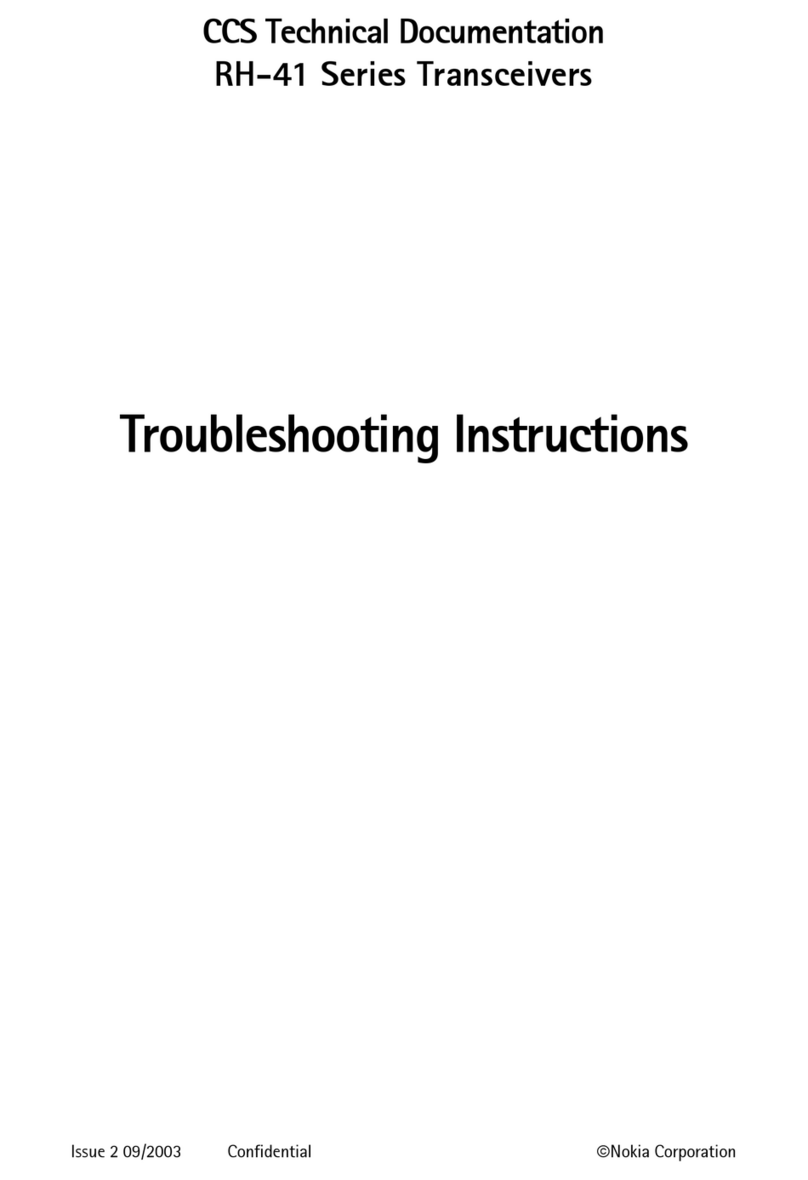
Nokia
Nokia RH-41 Series Troubleshooting instructions

Realistic
Realistic TRC-503 Service manual
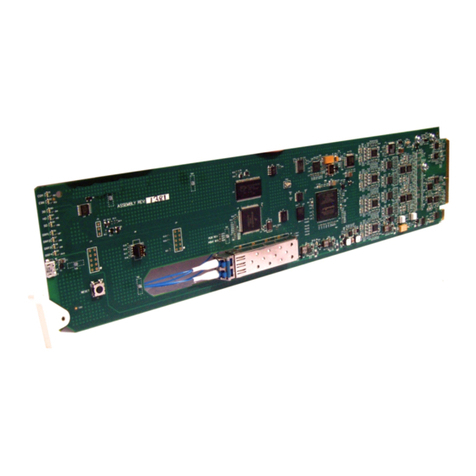
Cobalt Digital Inc
Cobalt Digital Inc 9433-EMDE-75/110 product manual
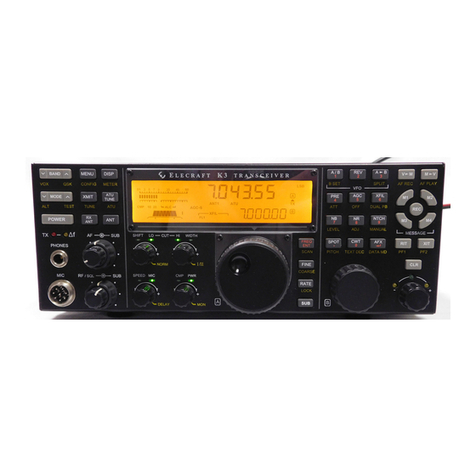
ELECRAFT
ELECRAFT KPA3 installation instructions
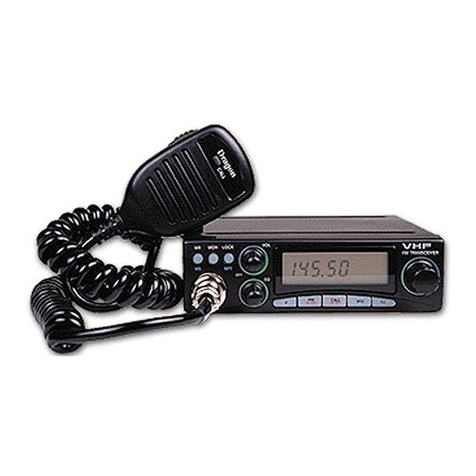
Albrecht
Albrecht AE 550 instruction manual

Vertex Standard
Vertex Standard VX-410 Series operating manual
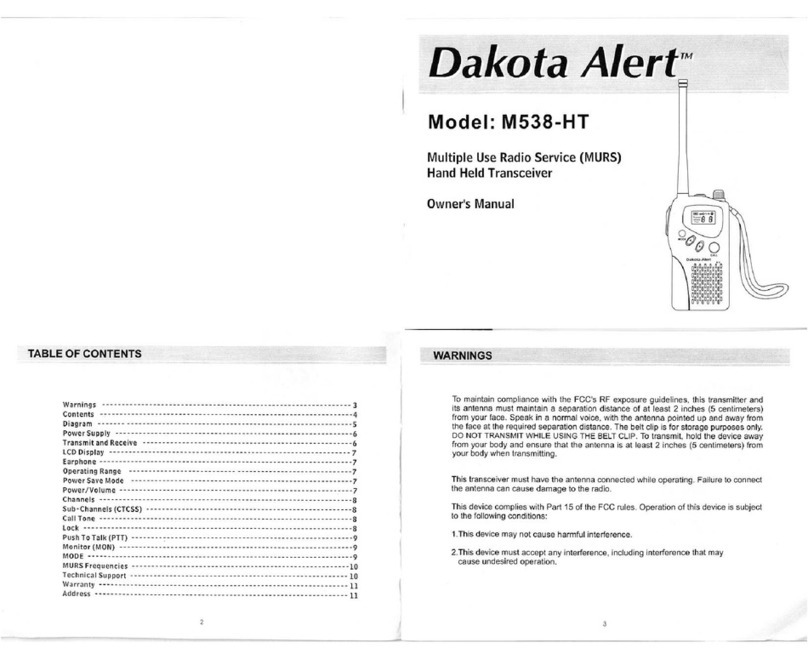
Dakota Alert
Dakota Alert M538-HT owner's manual
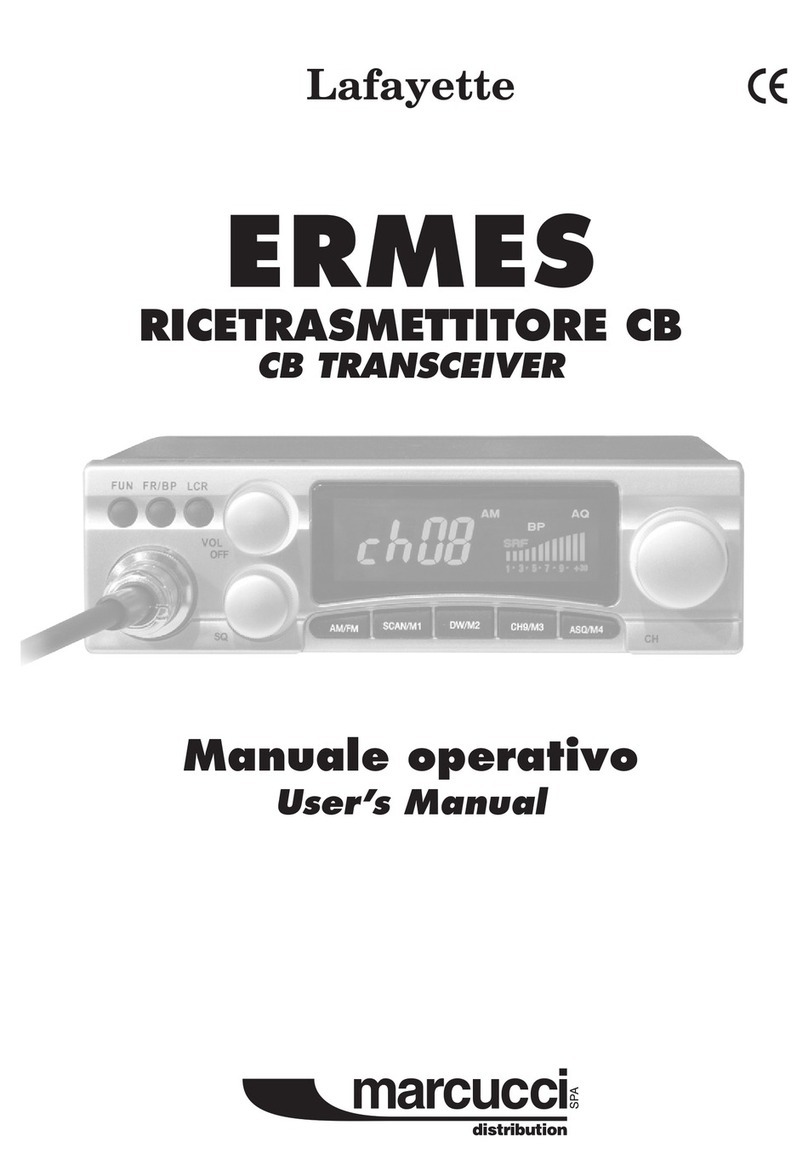
Lafayette
Lafayette ERMES user manual

Kenwood
Kenwood TK 3230 - FreeTalk XLS UHF instruction manual
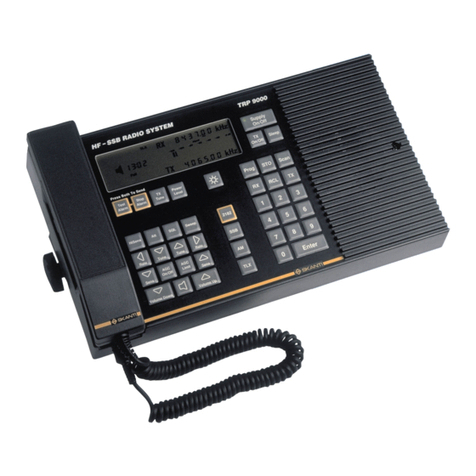
Skanti
Skanti TRP 9500 Technical manual
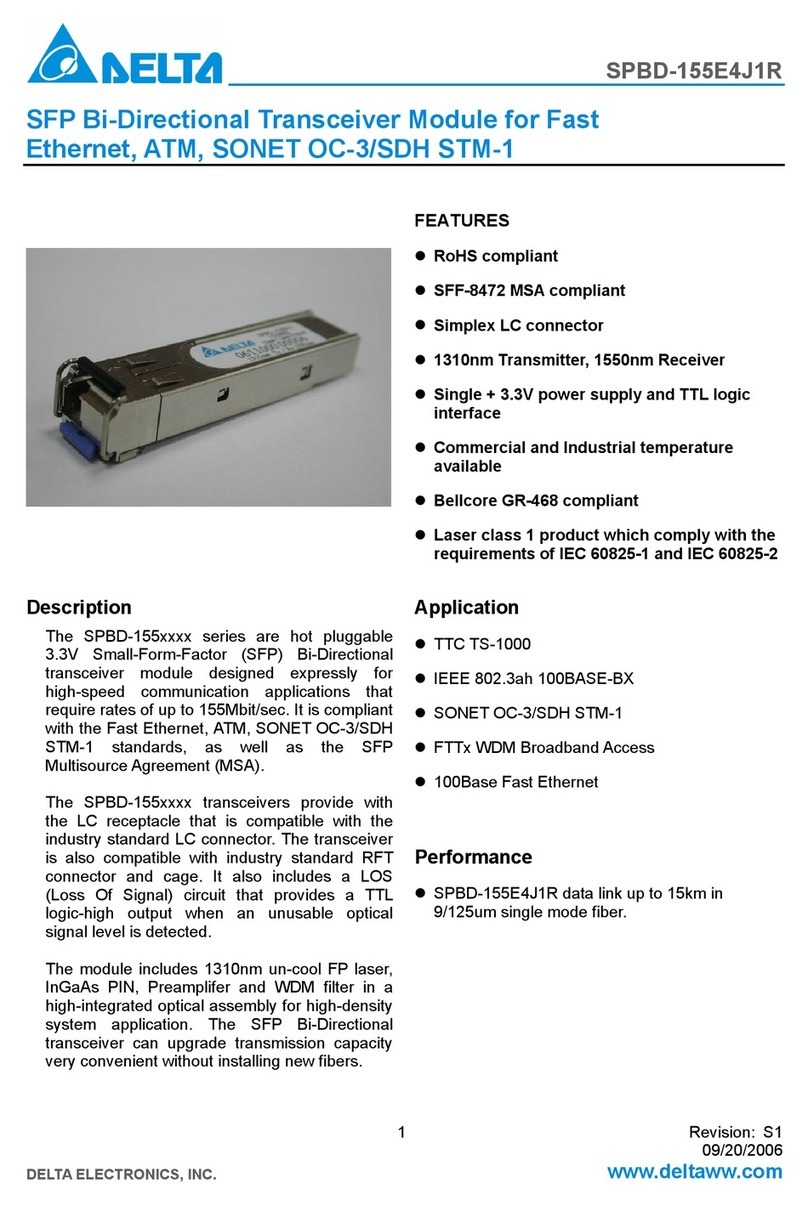
Delta Electronics
Delta Electronics SFP Bi-Directional Transceiver Module... Specification sheet
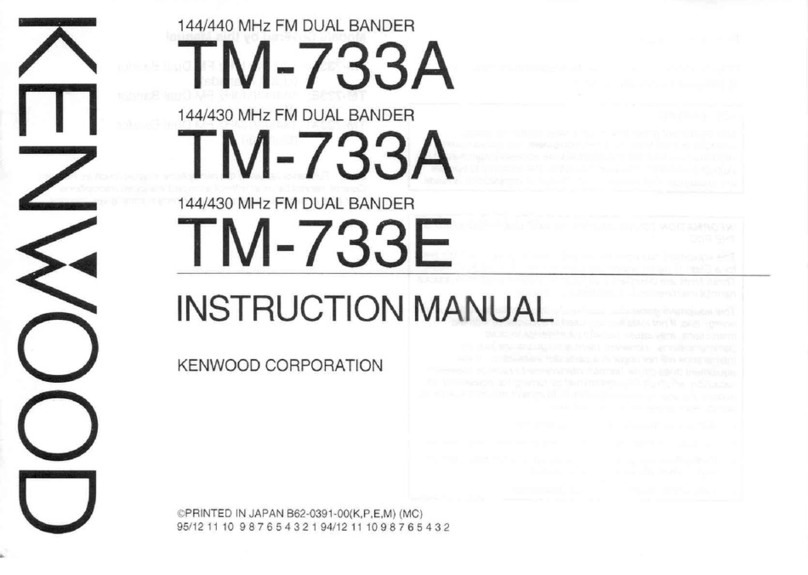
Kenwood
Kenwood TM-733A instruction manual
